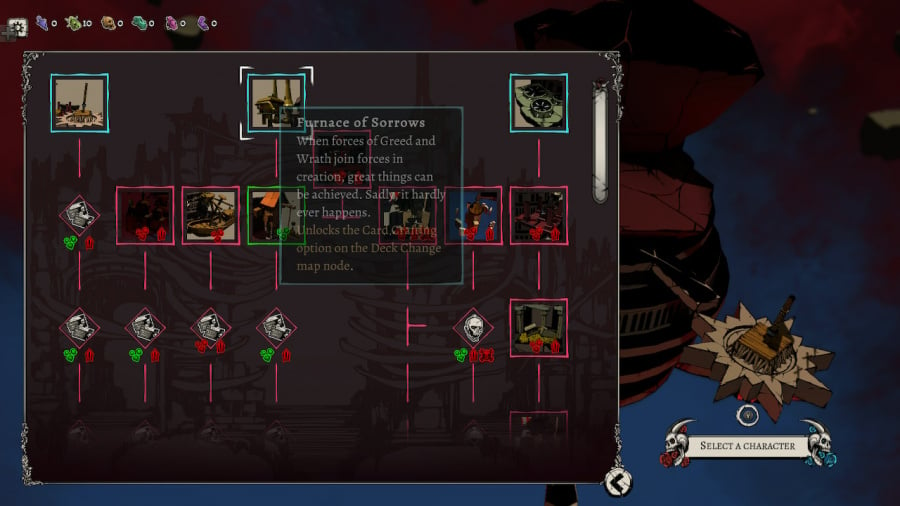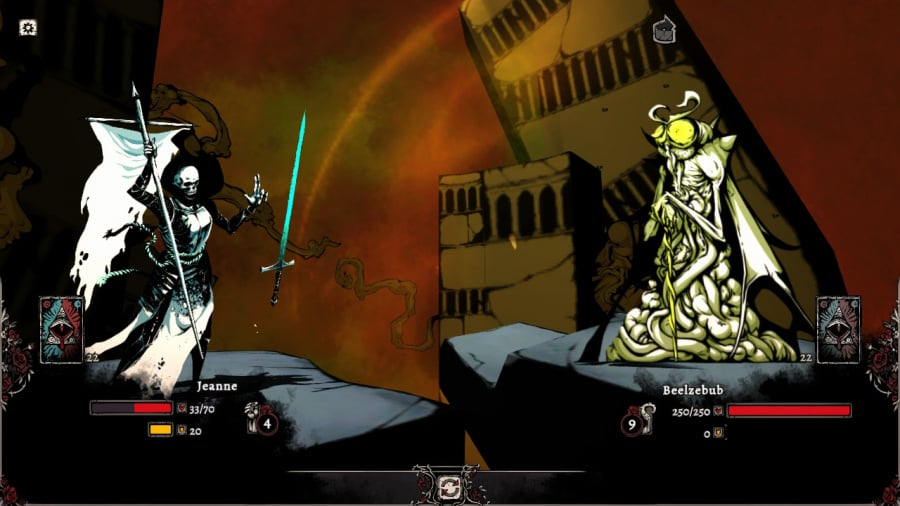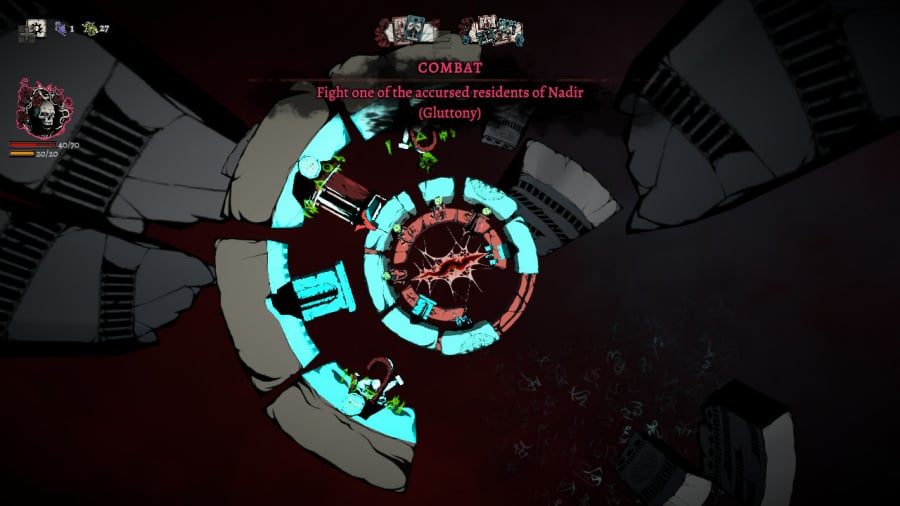Taking a trip to Hell has never looked quite so good as in Nadir: A Grimdark Deck Builder. The stunning visuals are enough to pull you in, while the card mechanics take seconds to learn yet provide a constant challenge. There are a lot of solid points to Nadir, but technical shortcomings and some bizarre design decisions keep it from reaching greatness.
Nadir: A Grimdark Deck Builder wastes no time throwing you into the fray. The tutorial has Jeanne d’Arc battling her way through a trio of unholy creatures, utilizing card-based combat to cut her way deeper back to the infernal city of Nadir. The mechanics are explained by the floating head of philosopher Friedrich Nietzsche, perhaps best known for his statement that “God is dead.”
The tutorial does a solid job of explaining the basics of the game, where the player draws cards that have a Blue and a Red power. Which power you can play depends on the number of Red or Blue cards the enemy has drawn. You can always tell exactly how the enemy will respond to your attacks, allowing you to plan your strategy appropriately.

However, this is a roguelike, so don’t expect things to be easy. Even the basic enemies you encounter can inflict serious status ailments, all of which stack on top of each other. While this can help you inflict up some impressive combos depending on how you’ve built your deck, it is more common that your opponent will have you bleeding, rusting, and decaying your way to another failed run.
Frustratingly, the tutorial section does very little to explain what these status ailments do and the controls don’t make it easy to check. Because this is a port of the PC version of the game, you have to try to navigate to the correct status ailment to get a rundown of what it does, which can be a challenge for the Joy-Con controllers. Other card powers, such as Stealth, aren’t explained at all until you try to use them, which is a baffling decision in a game that requires you to twist the rules in your favour to survive. Just a touch more care in how the game presents this information would have made Nadir much more fun to play.
In between runs, you can spend the resources you collect to build your home base. You can expand your deck, increase the health you recover when descending further into Hell, or you can unlock different characters to play as. Each character plays slightly differently, allowing you to choose how you’re going to tackle the variety of demons you face.

You start as Jeanne d’Arc, who represents Pride, and eventually unlock Vlad the Impaler as the embodiment of Lust, and Spanish conquistador Hernan Cortes, the latter representing the sin of Greed for his attacks against the native people in what is now Mexico in the 16th Century. It’s an interesting choice to include real-life historical figures in this way, especially ones known for their brutality. The serious impact of Cortes’ actions, for example, is still being felt in the world today. Then again, he’s in Hell, so he’s hardly being glorified for what he did.
In classic Dante’s Inferno fashion, you must fight your way through four circles of Hell, each ruled over by a different high demon. The opening splash page of the game shows a message from the developers, saying that they’re still working on the balance of these combats and that is painfully clear when you reach the bottom of a circle and face off against the final boss. They have so much health and deal so many status ailments that it feels impossible. We know that roguelikes are meant to be hard, but this just becomes frustrating after half a dozen runs and still not feeling any closer to victory.
A handful of technical errors popped up during our time with the game. All of the ones we encountered were minor, such as the explanation of card powers occasionally not showing up when you highlight them, but they make Nadir feel inconsistent, unpolished, and unfinished at this stage.

The only area where this game consistently succeeds is in its visuals. If you’ve ever seen a metal album, you’ll probably be familiar with the art style of Nadir. It feels like a Guns N’ Roses or Iron Maiden album cover come to life and we mean that in the most complimentary way; the gnarliest intermingling of life and death as displayed in thick folders at your local tattoo parlour. There are touches, such as the thick outlines and the liberal use of shading, that felt very Hellboy to us.
Nadir looks best in docked mode, where the visuals are given a chance to shine on a larger screen. The art still looks good in tablet mode, but it also makes some of the text too small to see clearly. Especially in the shop that pops up occasionally during runs, we had to squint hard to see what it was we were meant to be buying. Touches like this reinforce the feeling that this was a rushed port to the Switch from PC rather than something where Switch was considered from the beginning of development.
At launch, it is hard to recommend Nadir: A Grimdark Deckbuilder on the merits of its gameplay. The steep difficulty curve is more frustrating than challenging and the lack of information about some of the mechanics is simply baffling. If the developers put out an art book with these character designs, we would be all over it. However, the game around it feels almost like an afterthought, leading to an inconsistent and frustrating experience, but one that has potential.
Conclusion
Nadir: A Grimdark Deckbuilder succeeds in delivering a visually beautiful experience, but the game around these gorgeously metal images doesn’t feel like it had the same care as the art design. It is frustratingly difficult, a fact exacerbated by the inconsistently presented information and issues around how the game’s controls were ported to the Switch. This is a game that feels unfinished, despite the visual flair it offers.
Read the full story at: Source link
